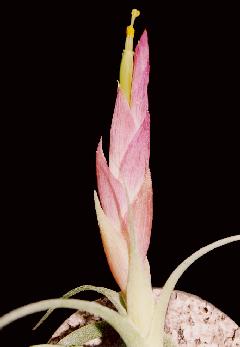


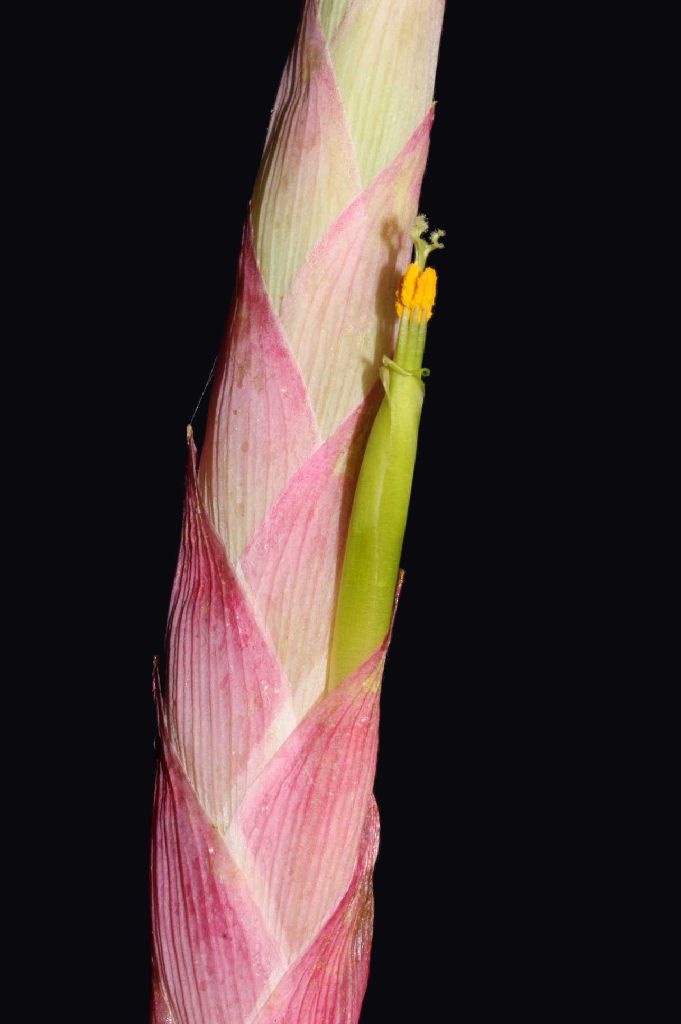

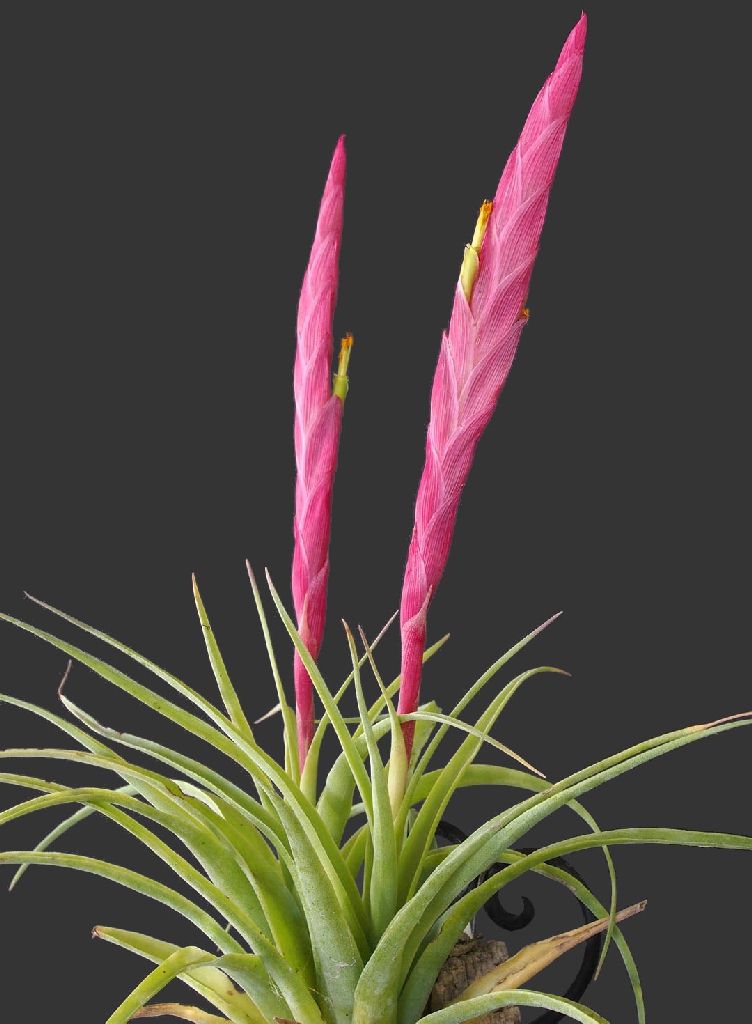
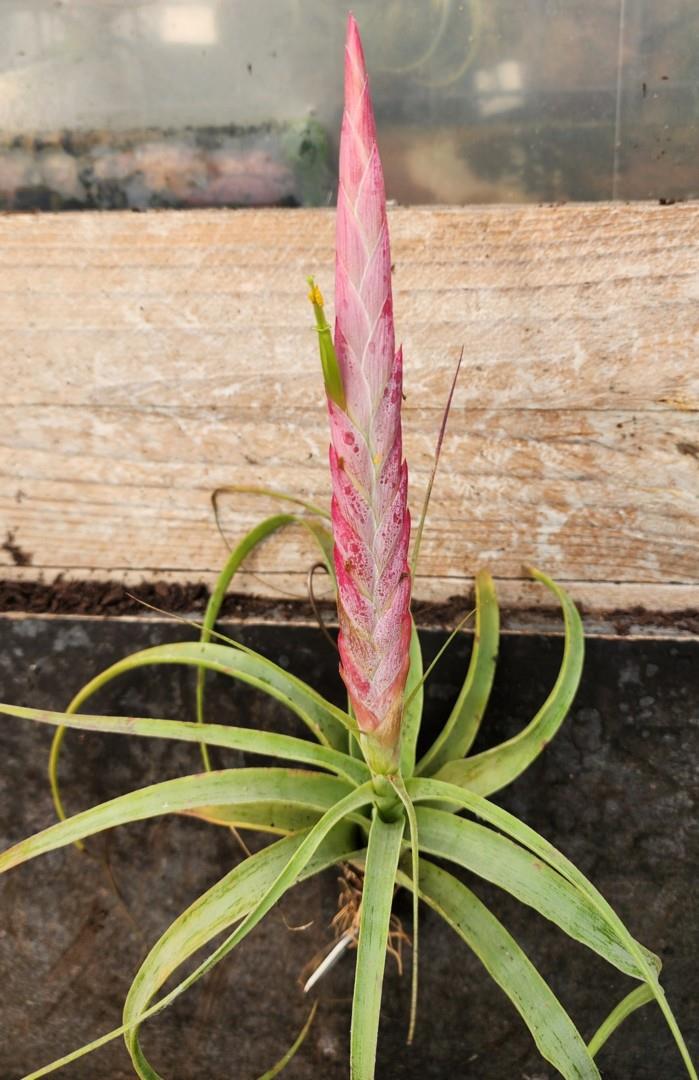

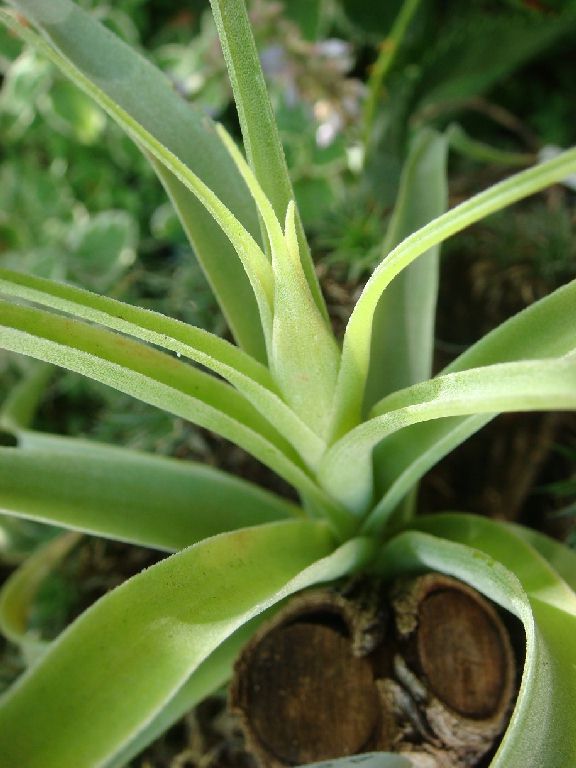

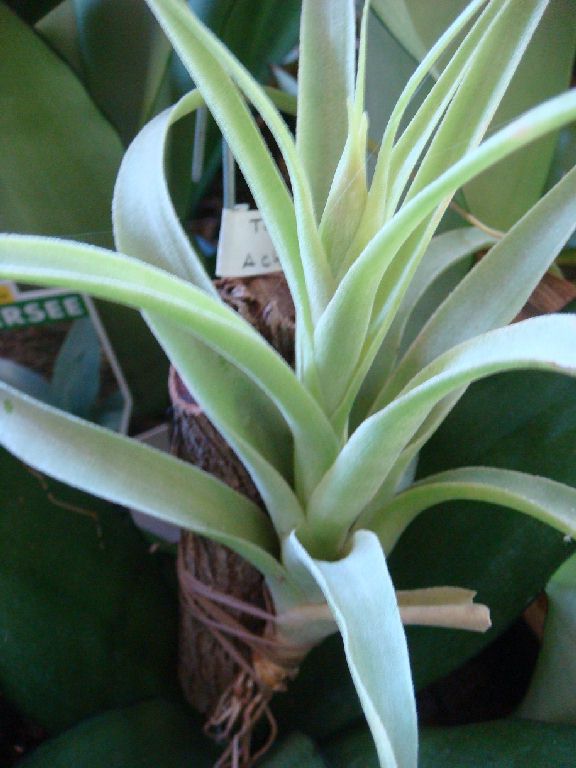
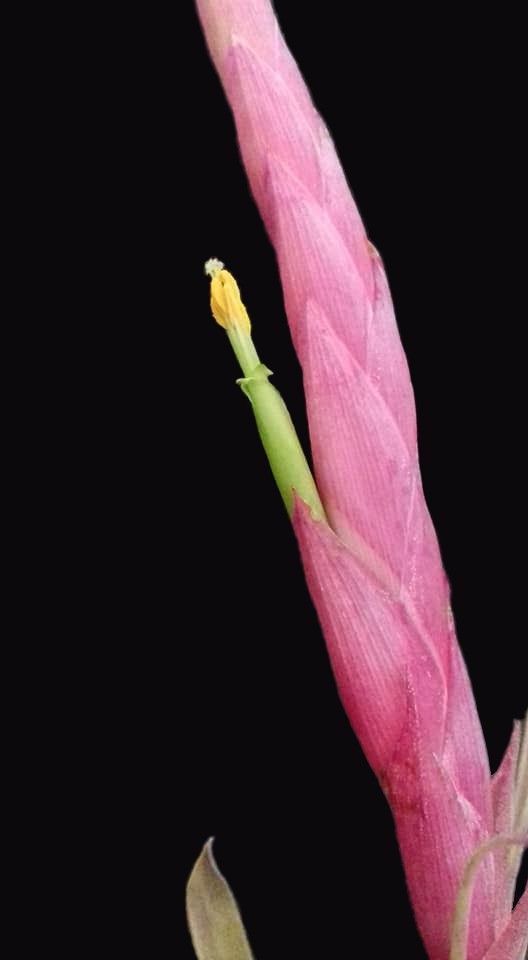
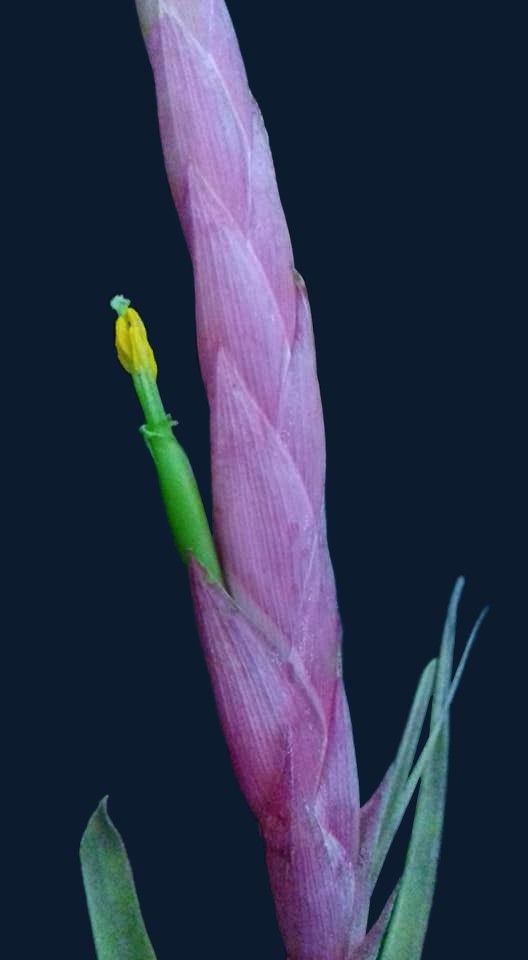
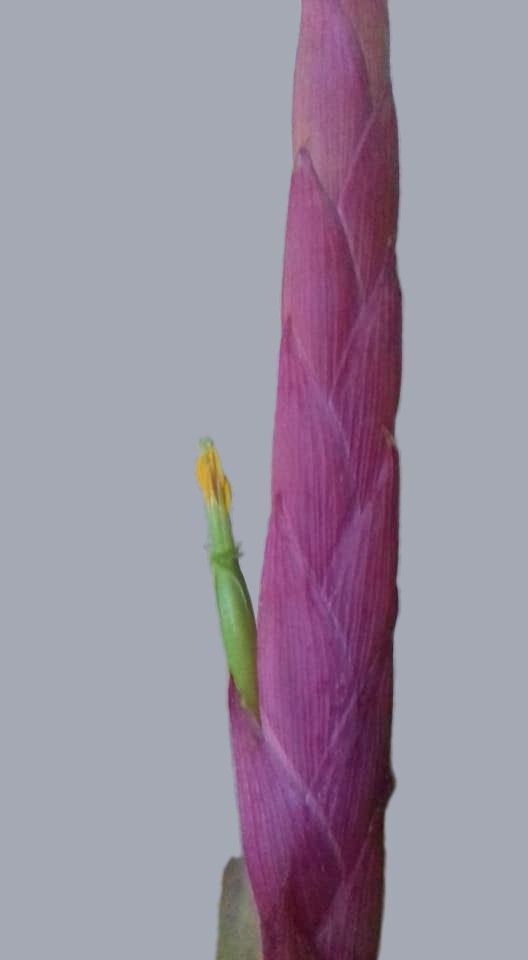
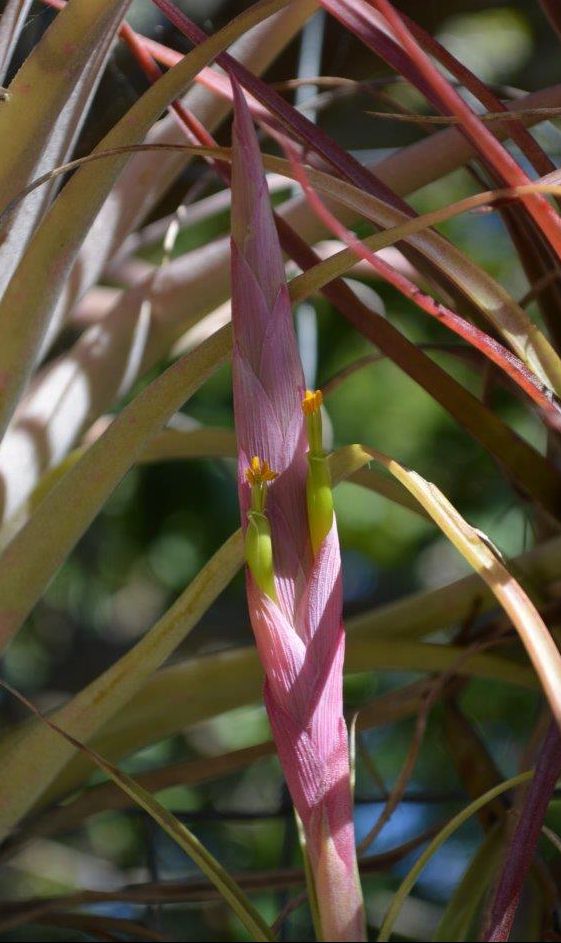
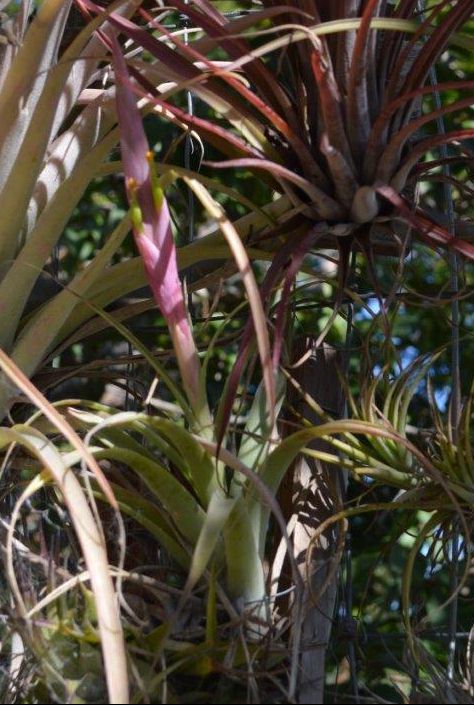
Tillandsia achyrostachys var stenolepis L. B. Smith, Contr. U. S. Natl. Herb. 29: 505. 1951. Not now considered a variety.
Floral bracts narrow, not altogether concealing the rhachis, not over 3 cm long. Type. Pringle 4111 (holotype US, isotypes BM, F, GH, MO, NY, S), on burseras, hills near Guadalajara, Jalisco, Mexico, 25 Jun 1892.
DISTRIBUTION. Epiphytic in dry habitats, 1140-1850 m alt, Mexico.
MEXICO. CHIHUAHUA: Rio Candemena, Rio Mayo headwaters, 23 Jun 1937, LeSeur 1288 (F, GH, MO). DURANGO: Corral de Piedra, Rio Piaxtla, Apr 1943, Lundell13007 (GH, LL); 13011 (LL). NAYARIT: Ahuacatlin, 25 May 1849,Gregg 995 ep (MO); Tepic,28 Aug 1948 (fl. in cult. May 1949), Dressler 331 (MO). JALISCO: Guadalajara, 28 Sep 1891, Pringle 5170 (GH); 19 Sep 1897, Rose 3022 (US); Rio Santiago, May 1912, Diguet s n (MICH, P, US); Ciudad Guzman, 23 Oct 1940, Moore 173 (GH); Mezquitic, 16 Apr 1951, McVaugh 12018 (MICH, US); San Luis Soyatlin, 28 Jun 1957, McVaugh 15064 (MICH). GUANAJUATO: Santa Rosa, 1901, Duges s n (GH). PUEBLA: Tepexco, 22 Aug 1965, Hernandez s n (IPMEX). MEXICO: Ixtapan de la Sal, 9 Jan 1964, Rzedowski 18236 (IPMEX). MICHOACAN: 70 km from Temascal toward Huetamo, 13 Nov 1949, Moore, Hernandez, & Porras 5683 (BH). COLIMA: Tamazula, 24 Feb 1960, Van Hyning 612 (US). OAXACA: Totolapa to San Carlos, Apr 1895, Nelson 2545 (US); San Juan Guelache, Etla, 19 Dec 1969, MacDougall s n (US).
From McVaugh in Flora Novo Galiciana 1989
Tillandsia achyrostachys E. Morr. ex Baker, Handb. Bromel. 171. 1889. Represented in Mexico by two varieties. The var. achyrostachys, with ovate densely imbricated floral bracts, is known from Mex., Mor., Oax., Pue.
The type was a drawing made by Morren from a cultivated plant originally from Mexico (K, the holotype). In the following rather doubtfully distinct variety the floral bracts are narrower, not always wholly concealing the rachis.
Tillandsia achyrostachys var. stenolepis L. B. Smith, Contr. U.S. Nat. Herb. 29: 505. fig. 68e. 1951.
Rocky hills and barrancas, on trees in tropical deciduous forest or pine-oak forest, often in rather dry situations, (400-) 900-2300 m on the Pacific slope and inland in the Santiago basin and other interior basins, flowering Feb-?Sep.
Chih., Dgo., ?s Zac., Nay., Gto., Jal. (Guadalajara, Pringle 4111, US!, the holotype), Col., Mich., Oax.
E of Mezquitic (McVaugh 12018); above the lake at Santa Maria del Oro (Feddema 694); W of Ahuacatlan (?Gregg 995 p.p.); Barrancas {between Tequila and Plan de Barrancas}, 25 May 1849 (Gregg 896, MO); Mpio. Hostotipaquillo, San Pedro Analco, 2000 m (Pineda Hernandez s.n., IBUG); Mpio. Ameca, Portezuelos (Lomeli Guerrera s.n:, IBUG); Bolanos to Guadalajara (Rose 3022); Mpio. Cuquio, road to Rio de Agua Caliente (Puga & Carvajal 10365, IBUG); 10 km {S} of San Cristobal de la Barranca, pine-oak forest (Castro Castro 96, IBUG); "barranca du rio Santiago" (Diguet in 1912, MICH); Mpio. Jocotepec, above El Molino, Potrero La Lima, 2300 m (Vargas Inclan 8, IBUG); 6 km E of San Luis Soyatlan (McYaugh 15064); S of Mascota, pine-oak forest (Hernandez Guerrero s. n., IBUG); Cruz de Romero near Talpa,1320 m (Ballesteros Franco s. n., IBUG); Mpio. {?V. Carranza}, 20 km E of Tonaya (Valenzuela Z.110, IBUG); SE of Ciudad Guzman (Moore 173, GH, cited by Smith, not seen); near Tamazula (Van Hyning 612, US); km 18 between Colima and Manzanillo, 400 m (Valenzuela Z.106, IBUG).
Stemless, 20-40 cm high;
leaves crowded in a rosette, 20-27 cm long, densely and finely pale-lepidote throughout;
sheaths erect, subtriangular, elongate, merging insensibly into the blades, these usually curved, spreading, very narrowly triangular, flat, 1 cm wide near base, filiform-attenuate;
inflorescence erect, simple, the spike linear in outline, acute, 10-20 cm long, 8-15 mm in diameter, terete or subterete at anthesis, glabrous, the flowers sessile, distichous (?or the lower ones polystichous);
scape-bracts closely imbricated, the lower foliaceous, the upper broadly elliptic, filiform-caudate or apiculate, thin, densely lepidote;
floral bracts erect, narrow, 2.5-3.6 cm long, in profile 6-8 mm wide, not always wholly concealing the rachis, much longer than the internodes, exceeding the sepals, ecarinate, papery, glabrous, closely and strongly nerved, bright red;
sepals lanceolate, up to 2.5-2.8 cm long, keeled, glabrous, membranous, prominently nerved, the adaxial (posterior) ones short-connate;
petals tubular-erect, ligulate, 4.5 cm long, obtuse, yellow or pale-green or "citron" (G);
stamens and pistil exserted:
fruit slenderly ellipsoid, abruptly short-beaked, 3-3.6 cm long.
This is the commonest stemless Tillandsia at middle elevations throughout Nueva Galicia, and the only one there with the flowers in a narrow simple glabrous long-pedunculate spike. Unbranched inflorescences sometimes occur in species that normally produce several or many spikes, but these species are found almost without exception in the Pacific lowlands.
Diversity and Genetic Structure of the Mexican Endemic Epiphyte Tillandsia achyrostachys E. Morr. ex Baker var. achyrostachys (Bromeliaceae).
ORIGINAL ARTICLE
Annals of Botany. 94(4):545-551, October 2004.
Gonzalez-Astorga, Jorge ; Cruz-Angon, Andrea ; Flores-Palacios, Alejandro ; Vovides, Andrew P.
Abstract:
Background and Aims: The monoecious, bird-pollinated epiphytic Tillandsia achyrostachys E. Morr. ex Baker var. achyrostachys is an endemic bromeliad of the tropical dry forests of Mexico with clonal growth. In the Sierra de Huautla Natural Reserve this species shows a host preference for Bursera copallifera (Sesse & Moc ex. DC) Bullock. As a result of deforestation in the study area, B. copallifera has become a rare tree species in the remaining forest patches. This human-induced disturbance has directly affected the population densities of T. achyrostachys. In this study the genetic consequences of habitat fragmentation were assessed by comparing the genetic diversity, gene flow and genetic differentiation in six populations of T. achyrostachys in the Sierra de Huautla Natural Reserve, Mexico.
Methods: Allozyme electrophoresis of sixteen loci (eleven polymorphic and five monomorphic) were used. The data were analysed with standard statistical approximations for obtaining diversity, genetic structure and gene flow.
Key Results: Genetic diversity and allelic richness were: HE=O.21 +/- 0.02, A=1 .86 +/0.08, respectively. F-statistics revealed a deficiency of heterozygous plants in all populations (Fit=O.65 +/- 0.02 and Fis=O.43 +/- 0.06). Significant genetic differentiation between populations was detected (Fst=O.39 +/- 0.07). Average gene flow between pairs of populations was relatively low and had high variation (Nm=O.46 +/- 0.21), which denotes a pattern of isolation by distance. The genetic structure of populations of T. achyrostachys suggests that habitat fragmentation has reduced allelic richness and genetic diversity, and increased significant genetic differentiation (by approx. 40%:) between populations.
Conclusions: The F-statistic values (>0) and the level of gene flow found suggest that habitat fragmentation has broken up the former population structure. In this context, it is proposed that the host trees of T. achyrostachys should be considered as a conservation priority, since they represent the limiting factor to bromeliad population growth and connectivity.